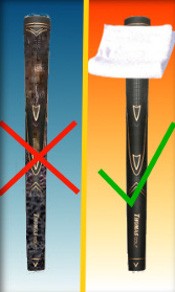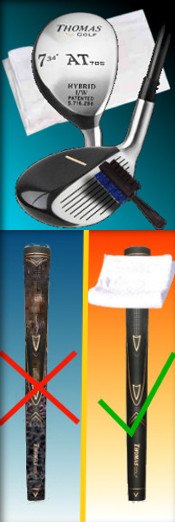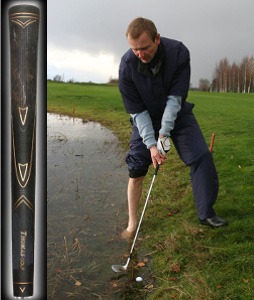Old, worn-out grips can really short-circuit your game, and not just in the obvious way.
The obvious way being that worn grips are slick and susceptible to slipping during your swing. This usually happens on the transition from backswing to downswing, or as your hands near the impact position. In any case, it's virtually impossible to make good contact once the club has shifted in your hands.
The trouble starts before that, though. Worn grips are naturally thinner than fresh ones, and even a small difference in thickness can lead to overactive hands and big hooks. Even worse, slick grips cause you – consciously or not – to hold the club tighter. That's a big no-no, as it creates tension in the wrists, arms and shoulders.
If your grips show a visible shine (or worse yet, cracking), it's definitely time to replace them. If they've still got a little roughness on the surface, dip them with dishwashing soap and water, then scrub with a plastic-bristled brush or a towel. Next, rinse the grips in hot water and dry them thoroughly. This will remove dirt and oil, restoring a nice, tacky feel.
While there's no formula for how often grips should be replaced, anyone who plays every week should re-grip yearly. Pay attention to the condition of your grips and wash them every 8-10 rounds, more often if you play in hot, sticky weather.
You'll be amazed at the difference new or clean grips can make.
As a golfer, one of your main jobs is to control the club throughout the swing.

From start to finish, you need to be in complete control of the club if you are going to hit good shots. If there is any loss of control between your hands and the club as you swing, it is going to be impossible to know what to expect at the moment of impact. You are only going to get to the point of trusting your swing if you can actually keep the grip of the club in place while the swing is in motion.
For many golfers, this means they will squeeze onto the handle of the club as tightly as possible. That might seem like a good plan, but it actually comes with its own drawbacks. When there is too much tension in your hands and wrists during the swing, it is hard to let the club move freely through the ball. Your release will be restricted, and you will lose power as a result. Not only that, but you may struggle to make solid contact. It is common for amateur golfers to hold onto the club too tightly, so this is a mistake you need to watch for in your own game.
So, if you can't squeeze tightly onto the handle during the swing, how do you keep the club in place? The answer can be found in your grips. The pieces of rubber that cover the end of the shaft on each of your clubs need to be in good condition so they can offer the right amount of control. If your grips are worn down and slick, you'll have no choice but to hold on tight – the club may fly out of your hands otherwise.
Plenty of golfers pay close attention to their equipment, but somehow many players overlook the importance of their grips. This might seem like an insignificant part of your overall golf equipment setup, but nothing could be further from the truth. As the only point of contact between your body and the club, your grips need to be ready for each swing, all day long. It is not an overstatement to say that your game can be ruined by worn out grips, even if your swing is working beautifully.
In this article, we are going to cover the basics of keeping good grips in place on your set of clubs. How do you care for your grips? How do you know when it is time for new grips? What should you look for when shopping for replacements? We will answer all of these questions and more in the content below.
All of the tips in this article have been written from the perspective of a right-handed golfer. If you happen to play left-handed, please take a moment to reverse the directions as necessary.
Basics of Grip Care

If you are like most golfers, you probably haven't thought much about taking care of your grips. On the surface, it doesn't seem like there would be much to do. Sure, you would dry them off if they got particularly wet during a rainy round, but that's probably about as far as it goes. Unfortunately, failing to care for your grips is a mistake which can have a couple of negative outcomes. For one thing, your grips will not perform as well from round to round when they are ignored, and you'll likely need to hold on tighter to keep the club in your hands. Also, the useful life of the grips may be shortened, meaning you will need to spend money sooner to have them replaced.
The list below offers up some basic tips on grip care. These are pretty easy steps to take, and they can benefit you in both the short- and long-term.
- Post-round wipe down. While you may not think about it very often – or at all – there are oils present in your skin which are going to be transferred to the grips as you play. After just one or two swings, this won't amount to much. After a full round, however, that starts to change. This is especially true with the clubs you use frequently, like the driver and your wedges. So, it is good to get into the habit of wiping down your grips after each round with a damp, soapy towel. Dip a small towel in some lightly soaped water and use that to wipe down the surface of the grip. Then, use another towel to dry off the grip, and set the club aside. Cleaning an entire set full of grips should only take a few minutes. Even if you don't get into the habit of doing this after each round, make a point to do it at least once in a while. Also, you are going to be making a lot of swings anytime you visit the range for a practice session, so cleaning your grips after those outings is helpful as well.
- Store your clubs in a smart place. You don't want to expose your clubs to extreme temperature changes if it can be avoided. The rubber that is used to make your grips is not going to respond kindly to particularly hot or cold weather, so the life of the grips may be shortened as a result. Usually, it is perfectly fine to keep them in the garage, but in the house would be even better in terms of temperature control. Leaving them out in the trunk of your car is not a great option, especially if you live in a climate where extreme temperatures are common. For instance, if the days get quite hot, or the nights get very cold, asking your clubs to live in your vehicle won't do any favors for your grips.
- Recovering from a wet round. From time to time, you are likely to wind up playing a round of golf in the rain. Golf is an outdoor game, of course, and you can't control the weather conditions. While most golfers will stay home on a particularly wet day, you might find yourself playing through some showers on occasion. That really isn't a big deal, as long as you are prepared for the conditions (and as long as the conditions are safe – if dangerous weather moves in, get off the course immediately). When you finish with a wet round, take everything out of your bag so it can dry thoroughly. This is an important step for the condition of all of your gear, including your grips.
There is nothing complicated about taking care of your grips. It comes down to providing them with simple care on a regular basis, keeping them in a smart place, and helping them to dry out after a rainy day. You'll find that none of these steps actually take up much of your time, and you will enjoy the feeling of starting each round with grips that feel tacky and ready for the job at hand. Of course, even the best maintenance plan can't make your grips last forever. In the next section, we will take a look at some signs that it may be time to replace your grips.
Signs of Trouble

It is easy enough to just fall into a pattern of playing round after round with your current set of clubs, not thinking much about how they might be changing as you go. While the clubs will look mostly the same from round to round, you can be sure that subtle changes are taking place. For example, each iron shot you hit is going to slightly wear down your grooves, and eventually the clubs won't be able to perform properly. This is especially true for wedges.
As you might imagine, every swing you make is also going to wear down the condition of your grips. Not dramatically, of course – this is a gradual, subtle process. Every practice swing, range swing, and swing on the course is going to take your grip a little bit closer to the end of its useful life. As a golfer, it is your job to monitor the condition of your grips, to make sure they have not reached the point of needing to be replaced. As part of the monitoring process, watch for the following warning signs.
- A visual shine. One of the best ways to tell that your grips are wearing down significantly is actually to look at them, rather than feel them. If your grips look shiny, that's a bad sign. This means that much of the texture on the surface of the grip is gone, and you'll probably need to hold on tighter in order to keep control of the club. This is not a perfect measuring stick, as it's possible for grips to have a dull appearance and still be worn, but it is a good starting point.
- Impossible in the rain. It is always going to be a little more difficult to grip your clubs in wet conditions, but it shouldn't be impossible. If you can't seem to secure your clubs when the rain is falling, it's probably time for new grips. There isn't anything fun about having to wrestle your clubs on each swing during a wet round, and you certainly don't want to lose control and let the club go flying. If you play any golf at all in the rain – even on an occasional basis – make sure to keep fresh grips on all of your clubs.
- Changes to the shape of the grip. As you continue to use your current grips, you may find that the rubber wears down in a pattern which matches up with the placement of your fingers on the grip. Eventually, the grip will lose its shape to some degree, and it may not allow you to swing the club properly. Take a look at your grips from time to time to see if they are losing their shape. It's okay to use grips which have worn down slightly in this way, but don't let it go too far before having them replaced.
In the end, it really just comes down to paying attention. Keep a watchful eye on the condition of your grips so you can quickly spot anything that might lead to trouble on the course. Obviously, the way the grips feel as you swing is a big indicator as well, so any minor slipping should be addressed. Given the relatively marginal cost of replacing your grips, this is a golf equipment point which should not be ignored for long.





